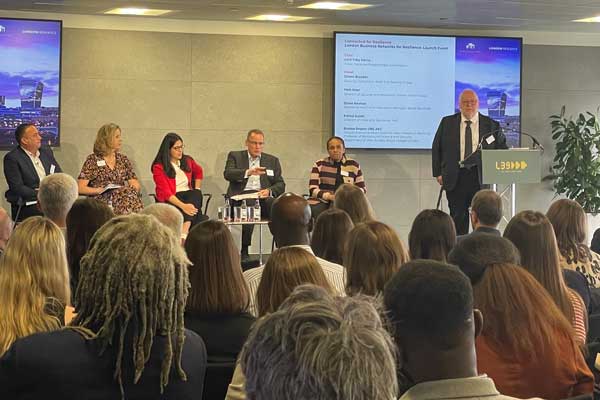PwC UK Crisis and Resilience Geopolitical Risk Team
In today’s frenetic global environment, geopolitical shockwaves are regularly being sent around the world. The geopolitical landscape is being re-shaped at a pace we have not seen for decades. We are faced with conflicts, new and potentially perilous international alliances, flashpoints in regions crucial to global stability, and the looming threat of tariffs and trade wars.
This rapidly evolving global outlook presents both risks and opportunities. Even those organisations without a prima facie exposure to these issues, may be affected by second or third order impacts. In such a volatile and ever-changing world, where organisations have no control over the macro risks moulding their environment, how can they ensure survival? And how can they go one step further to not just survive, but thrive?
Risk and Resilience: A symbiotic relationship
To flourish amidst this chaos, organisations must adopt two parallel approaches:
- Issues-led approach to risk management: This involves identifying and proactively preparing for the key geopolitical issues, events or scenarios which can be anticipated.
- Impact-led approach to building resilience: This requires an introspective, scenario-agnostic perspective. Organisations need to pinpoint the strategic, financial, and operational characteristics crucial to their success and take measures to protect them.
The issues-led approach
An effective issues-led approach to managing geopolitical risk comprises four essential elements:
- Identify: Organisations need to horizon scan for geopolitical drivers that could impact them.
To establish effective horizon scanning, organizations should consider their intelligence sources and the questions being asked. Large organisations might develop in-house capabilities, integrating geopolitical expertise in areas like travel risk, financial risk, treasury and strategy. However, outsourcing might be more practical for many. The challenge is to filter the noise and distill swathes of information into valuable, relevant insights. - Analyse: The next step is to conduct an in-depth analysis of potential downside risks and upside opportunities.
In order to triage the long list of risks identified during horizon scanning, strategic, financial and operational implications should be considered. As the list becomes more focused, more in-depth analysis is required. Scenario planning is vital. Generating predictions in complex geopolitical environments carries significant risk and uncertainty. Analysing impacts and opportunities based on a range of plausible scenarios gives much greater assurance over the value of the outputs. In some cases, scenario planning can evolve into scenario modelling, offering quantitative analyses of different impacts.
As an aside, it is essential that this process is not conducted by risk professionals alone. As a profession, we are prone to focusing on the downside and will often miss the upside opportunities for value creation that geopolitical disruptions can present. - Act: Taking action to mitigate risks and exploit opportunities is vital. For today’s organisations to thrive, geopolitical analysis must be integrated into decision-making processes. Many organisations engage in informal horizon scanning (Board briefings and so on), and some will engage in high-level analysis of the potential impacts and opportunities. But unless decision-makers actively engage with this analysis, the organisation will never effectively manage these risks. Without buy-in and sponsorship, oversight and accountability, geopolitical risk management will remain nothing more than an interesting and diverting spectator sport.
- Monitor: Ongoing monitoring is essential given the pace of geopolitical change and the unpredictability of actions and reactions on a national scale. Monitoring capabilities should dovetail with horizon scanning capabilities. The primary characteristics of an effective monitoring capability include clear identification of trigger points and an unambiguous response structure. Individuals must understand who is responsible for assessing and responding as risks emerge and evolve.
As an aside, it is essential that these processes are not conducted by risk professionals alone. As a profession, we are prone to focusing on the downside and will often miss the upside opportunities for value creation that geopolitical disruptions can present.
VIEW CASE STUDY
An impact-led enterprise resilience capability
An issues-led approach can help organisations prepare for specific emerging situations. But no horizon scanning exercise can guarantee identification of every issue, and it is impossible for organisations to address all the issues they identify regardless of likelihood – there could be hundreds. Therefore, there is a requirement to build resilience so the organisation can withstand, absorb or recover from unforeseen shocks.
An enterprise resilience capability should focus on three key pillars: strategic, financial and operational resilience.
- Strategic Resilience: Strategic resilience in the context of geopolitical risk includes the longevity of business models, products and critical markets, M&A related risks and opportunities, impacts to workforce as migration patterns change, and building reputational resilience to withstand ESG-related shocks.
- Financial Resilience: Financial resilience is often well-established, but considering it in the context of geopolitical risks is less common. Traditionally equated with cost-cutting, bolstering the bottom line is a common approach to ensuring financially robust businesses. But when looking through the lens of geopolitical risk, consideration should also be given to the resilience of revenues and investments, exposure to credit and FX risk, and the liquidity required to withstand shocks.
- Operational Resilience: Not everything needs to be resilient. Organisations should identify the outputs which underpin the viability of the business – their lifeblood – and focus on protecting those. Wrapping resilience around the people, facilities, technology, third-parties and supply chains that support critical processes is essential. In a geopolitical context, bolstering supply chain resilience is often the focal point. Mapping the first, second, and third tier of critical supply chains, understanding their vulnerabilities to geopolitical risks, and implementing appropriate resilience strategies should be the bedrock of any geopolitical resilience capability.
Organisations often have pockets of expertise in building and managing strategic, financial, and operational resilience. The challenge lies in ensuring that geopolitical capabilities and analysis operate across these silos.
Where issues-led and impact-led approaches overlap
The issues-led and impact-led approaches outlined above are (or at least should be) symbiotic, and should have governance structures which reflect that relationship. In practical terms, one of the most important areas of overlap is testing. While resilience or impact-led capabilities can be built largely agnostic of scenario, once in place they need to be stress-tested against the evolving risk landscape.
Mature organisations are now evolving their testing regimes to encompass geopolitical disruptions: nation-state attacks on the supply chain (including critical national infrastructure and the hyperscalers); ESG and reputational issues associated with sanctions and trade restrictions; greyzone attacks on undersea infrastructure. This convergence of issues-led and impact-led capabilities in the testing arena can help provide assurance over geopolitical resilience.
Conclusion
Ultimately, organisations must address three key questions:
‘What?’
What is happening globally? Do you have reliable intelligence feeds offering a triangulated view of geopolitical events, and a process or framework for triaging this “noise” to focus on the most relevant geopolitical risks?
‘So what?’
What do these issues mean for you? Do you have the capability to analyse impacts and opportunities associated with specific issues, including first, second, and third-order impacts across scenarios? Effective analysis requires input from across the business.
‘So what now?’
What actions should be taken? All too often organisations ‘spectate’ on geopolitical risks. Consider the oversight and buy-in needed from decision-makers to effect organisational change in response to evolving geopolitical risks.
Even if organisations have robust capabilities in place to identify, analyse, act on and monitor specific geopolitical issues, unforeseen disruptions will still occur. A strong resilience capability provides the necessary controls to mitigate harm from unexpected events.
By integrating effective issues-led and impact-led approaches, organisations can navigate and thrive in a dynamic world fraught with geopolitical uncertainty.
PwC is helping clients with all of the above. If you would like to discuss how your organisation can build geopolitical resilience, we would be very happy to discuss further.
This blog has been produced as part of the ongoing Geostrategic Resilience Programme, a collaboration between PwC and Resilience First that includes webinars, in-person events, and blogs. The next event in the series is a virtual panel discussion on strengthening reputational resilience amid global uncertainty, taking place on 8 May from 13:00 to 14:00. Click here to learn more.



